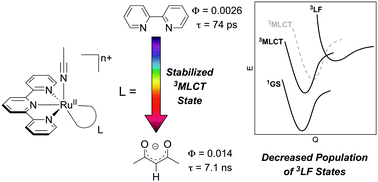Photoinduced ligand dissociation follows reverse energy gap law: nitrile photodissociation from low energy 3MLCT excited states†
Abstract
A series of Ru(II)-terpyridine complexes containing electron-donating bidentate ligands are able to effectively photodissociate nitrile ligands using red light. A spectroscopic investigation of these complexes reveal that they follow anti-energy gap law behavior, providing further evidence that population of 3LF excited states is not necessary for photoinduced nitrile dissociation.



 Please wait while we load your content...
Please wait while we load your content...